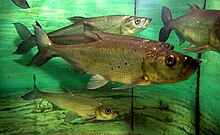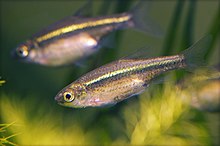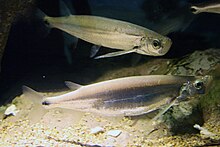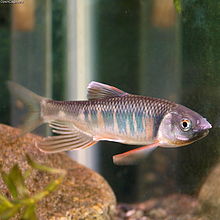Xenocyprididae
| Xenocyprididae | ||||||||||||
|---|---|---|---|---|---|---|---|---|---|---|---|---|

Silver carp ( Hypophthalmichthys molitrix ) |
||||||||||||
| Systematics | ||||||||||||
|
||||||||||||
| Scientific name | ||||||||||||
| Xenocyprididae | ||||||||||||
| Günther , 1868 |
The Xenocyprididae are a family of East Asian fish from the order of the carp-like (Cypriniformes). Three species of the Xenocyprididae, the grass carp , the marble carp and the silver carp are now also found in Europe and North America, but have been released by humans.
features
Most Xenocyprididae are small to medium-sized fish, but some can grow very large, such as the predatory Elopichthys bambusa , which can be up to two meters long , and the black amur ( Mylopharyngodon piceus ), which can weigh over 70 kg. The close relationship of all genera and species of the Oxygastrinae and their difference to the Bärblingen is based on molecular biological investigations and has not yet been supported by morphological characteristics.
Way of life
The species of Xenocyprididae live in small to medium-sized rivers, mostly close to the water surface, and feed mainly on invertebrates. Overall, however, the subfamily shows a wide range of adaptations to the available food spectrum and related specializations. Thus predatory carp , Elopichthys bambusa and macrochirichthys macrochirus fish-eating predatory fish, the marble carp ( Hypophthalmichthys nobilis ) feeds on zooplankton , while the silver carp ( Hypophthalmichthys molitrix ) phytoplankton preferred and the grass carp ( Ctenopharyngodon idella ) is fed by larger aquatic plants. The Black Amur feeds mainly on molluscs .
Systematics
The Xenocyprididae were introduced in 1868 by the German zoologist Albert Günther as a subfamily of the carp fish (Cyprinidae). For a long time they were relatively poor in species with only a little more than ten species in five genus ( Distoechodon, Hypophthalmichthys, Plagiognathops, Pseudobrama and Xenocypris ). In various phylogenetic studies, however, it was established that some species of Bärblings with the Bärblings i. e. S. (Danioninae) are only distantly related and these genera, mostly grouped together as "Ex-Danioninae", together with the Cultrinae, Hypophthalmichthyinae, Opsariichthyinae, Squaliobarbinae and Xenocypridinae form a monophyletic clade of East Asian carp fish. For this group, some ichthyologists suggested the name Oxygastrinae, others use the name Opsariichthyinae.
However, the Swiss ichthyologist Maurice Kottelat and Richard van der Laan and colleagues noted that Hypophthalmichthyinae Günther, 1868 and Xenocypridinae Günther, 1868 are the oldest names available for the taxon and must have priority over the names Opsariichthyinae and Oxygastrinae. In the Xenocypridinae, in the meantime the name has largely established itself, there are over 40 genera with around 150 species that were previously counted among the Bärblingen or the subfamilies Cultrinae, Hypophthalmichthyinae, Opsariichthyinae, Squaliobarbinae. The East Asian members of the former subfamily Alburninae (now Leuciscinae) are placed in the Xenocypridinae. Like many other subfamilies of the carp fish, the Xenocypridinae are increasingly being viewed as an independent family (Xenocyprididae).
Genera and species
|
The family relationships are illustrated by the following cladogram:
|
- Genus Anabarilius
- Anabarilius alburnops (Regan, 1914)
- Anabarilius andersoni (Regan, 1904)
- Anabarilius brevianalis Zhou & Cui, 1992
- Anabarilius duoyiheensis Li, Mao & Lu, 2002
- Anabarilius goldenlineus Li & Chen, 1995
- Anabarilius grahami (Regan, 1908)
- Anabarilius liui (Chang, 1944)
- Anabarilius longicaudatus Chen, 1986
- Anabarilius macrolepis Yih & Wu, 1964
- Anabarilius maculatus Chen & Chu, 1980
- Anabarilius paucirastellus Yue & He, 1988
- Anabarilius polylepis (Regan, 1904)
- Anabarilius qiluensis Chen & Chu, 1980
- Anabarilius qionghaiensis Chen, 1986
- Anabarilius songmingensis Chen & Chu, 1980
- Anabarilius transmontanus (Nichols, 1925)
- Anabarilius xundianensis He, 1984
- Anabarilius yangzonensis Chen & Chu, 1980
- Genus Ancherythroculter Yih & Wu, 1964
- Ancherythroculter daovantieni (Bănărescu, 1967)
- Ancherythroculter kurematsui (Kimura, 1934)
- Ancherythroculter nigrocauda Yih & Wu, 1964
- Ancherythroculter wangi (Tchang, 1932)
- Genus Aphyocypris Günther, 1868
- Aphyocypris amnis Liao, Kullander & Lin, 2011
- Aphyocypris arcus (Lin, 1931)
- Aphyocypris chinensis Günther, 1868
- Aphyocypris dorsohorizontalis (Nguyen & Doan, 1969)
- Aphyocypris kikuchii (Ōshima, 1919)
- Aphyocypris kyphus (May, 1978)
- Aphyocypris lini (Weitzman & Chan, 1966)
- Aphyocypris moltrechti (Regan, 1908)
- Aphyocypris normalis (Nichols & Pope, 1927)
- Genus Candidia Jordan & Richardson, 1909
- Candidia barbata (Regan, 1908)
- Candidia pingtungensis Chen, Wu & Hsu, 2008
- Genus Chanodichthys Bleeker, 1860
- Chanodichthys abramoides (Dybowski, 1872)
- Chanodichthys dabryi (Bleeker, 1871)
- Chanodichthys erythropterus (Basilewsky, 1855)
- Chanodichthys mongolicus (Basilewsky, 1855)
- Chanodichthys oxycephalus (Bleeker, 1871)
- Genus Ctenopharyngodon Steindachner, 1866
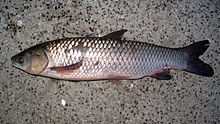 Grass carp ( Ctenopharyngodon idella )
Grass carp ( Ctenopharyngodon idella )- Grass carp ( Ctenopharyngodon idella ) (Valenciennes, 1844)
- Genus Culter Basilewsky 1855
- Culter alburnus Basilewsky, 1855
- Culter flavipinnis Tirant, 1883
- Culter oxycephaloides Kreyenberg & Pappenheim, 1908
- Culter recurviceps (Richardson, 1846)
- Genus Distoechodon Peters, 1881
- Distoechodon macrophthalmus Zhao, FF Kullander, SO Kullander & Zhang, 2009
- Distoechodon tumirostris Peters, 1881
- Genus Elopichthys Bleeker, 1860
- Elopichthys bambusa Richardson, 1845
- Genus Hainania Koller, 1927
- Hainania serrata Koller, 1927
- Genus Hemiculter Bleeker, 1860
- Hemiculter bleekeri Warpachowski, 1887
- Hemiculter elongatus Nguyễn & Ngô, 2001
- Hemiculter krempfi Pellegrin & Chevey, 1938
- Hemiculter leucisculus (Basilewsky, 1855)
- Hemiculter lucidus (Dybowski, 1872)
- Hemiculter songhongensis Nguyễn & Nguyen, 2001
- Hemiculter tchangi Fang, 1942
- Hemiculter varpachovskii Nikolskii, 1903
- Genus Hemiculterella Warpachowski, 1887
- Hemiculterella macrolepis Chen, 1989
- Hemiculterella sauvagei Warpachowski, 1887
- Hemiculterella wui (Wang, 1935)
- Genus Hemigrammocypris Fowler, 1910
- Hemigrammocypris rasborella Fowler, 1910
- Genus Hypophthalmichthys Bleeker, 1860
 Marble carp ( Hypophthalmichthys nobilis )
Marble carp ( Hypophthalmichthys nobilis )- Hypophthalmichthys harmandi Sauvage, 1884
- Silver carp ( Hypophthalmichthys molitrix ) (Valenciennes, 1844)
- Marble carp ( Hypophthalmichthys nobilis ) (Richardson, 1845)
- Genus Ischikauia Jordan & Snyder, 1900
- Ischikauia steenackeri (Sauvage, 1883)
- Genus Longiculter
- Longiculter siahi Fowler, 1937
- Genus Macrochirichthys Bleeker, 1860
- Macrochirichthys macrochirus (Valenciennes, 1844)
- Genus Megalobrama Dybowski 1872
- Giant sea bream ( Megalobrama amblycephala ), Yih, 1955
- Megalobrama elongata Huang & Zhang, 1986
- Megalobrama mantschuricus (Basilewsky, 1855)
- Megalobrama pellegrini (Tchang, 1930)
- Megalobrama skolkovii Dybowski, 1872
- Megalobrama terminalis (Richardson, 1846)
- Genus Metzia Jordan & Thompson, 1914
- Metzia alba (Nguyen, 1991)
- Metzia bounthobi Shibukawa, Phousavanh, Phongsa & Iwata, 2012
- Metzia formosae (Ōshima, 1920)
- Metzia hautus (Nguyen, 1991)
- Metzia lineata (Pellegrin, 1907)
- Metzia longinasus Gan, Lan & Zhang, 2009
- Metzia mesembrinum (Jordan & Evermann, 1902)
- Metzia parva Luo et al., 2015
- Genus Mylopharyngodon Peters, 1881
 Black Amur ( Mylopharyngodon piceus )
Black Amur ( Mylopharyngodon piceus )- Black Amur ( Mylopharyngodon piceus ) Richardson, 1846
- Genus Nipponocypris Chen, Wu & Hsu, 2008
- Nipponocypris koreanus (Kim, Oh & Hosoya, 2005)
- Nipponocypris Sieboldii (Temminck & Schlegel, 1846)
- Genus Ochetobius Günther, 1868
- Ochetobius elongatus (Kner, 1867)
- Genus Opsariichthys Bleeker, 1863
- Opsariichthys bea Nguyen, 1987
- Opsariichthys bidens Günther, 1873
- Opsariichthys dienbienensis Nguyen & Nguyễn, 2000
- Opsariichthys duchuunguyeni Huynh & Chen, 2014
- Opsariichthys evolans (Jordan & Evermann, 1902)
- Opsariichthys hainanensis Nichols & Pope, 1927
- Opsariichthys hieni Nguyen, 1987
- Opsariichthys kaopingensis Chen & Wu, 2009
- Opsariichthys pachycephalus Günther, 1868
- Opsariichthys songmaensis Nguyen & Nguyễn, 2000
- Opsariichthys uncirostris (Temminck & Schlegel, 1846)
- Genus Oxygaster van Hasselt, 1823
- Oxygaster anomalura van Hasselt, 1823
- Oxygaster pointoni (Fowler, 1934)
- Genus Parabramis Bleeker, 1865
- Parabramis pekinensis (Basilewsky, 1855)
- Genus Parachela Steindachner, 1881
- Parachela cyanea Kottelat, 1995
- Parachela hypophthalmus (Bleeker, 1860)
- Parachela ingerkongi (Bănărescu, 1969)
- Parachela maculicauda (Smith, 1934)
- Parachela oxygastroides (Bleeker, 1852)
- Parachela siamensis (Günther, 1868)
- Parachela williaminae Fowler, 1934
- Genus Paralaubuca Bleeker 1864
- Paralaubuca barroni (Fowler, 1934)
- Paralaubuca harmandi Sauvage, 1883
- Paralaubuca riveroi (Fowler, 1935)
- Paralaubuca stigmabrachium (Fowler, 1934)
- Paralaubuca typus Bleeker, 1864
- Genus Parazacco Chen, 1982
- Parazacco fasciatus (Koller, 1927)
- Parazacco spilurus (Günther, 1868)
- Genus Plagiognathops Berg, 1907
- Plagiognathops microlepis (Bleeker, 1871)
- Genus Pogobrama
- Pogobrama barbatula (Luo & Huang, 1985)
- Genus pseudobrama Bleeker, 1870
- Pseudobrama simoni (Bleeker, 1864)
- Genus Pseudohemiculter Nichols & Pope, 1927
- Pseudohemiculter dispar (Peters, 1881)
- Pseudohemiculter hainanensis (Boulenger, 1900)
- Pseudohemiculter k Weichowensis (Tang, 1942)
- Pseudohemiculter pacboensis Nguyễn, 2001
- Genus Pseudolaubuca Bleeker, 1864
- Pseudolaubuca engraulis (Nichols, 1925)
- Pseudolaubuca hotaya May, 1978
- Pseudolaubuca jouyi (Jordan & Starks, 1905)
- Pseudolaubuca sinensis Bleeker, 1864
- Genus Rasborichthys
- Rasborichthys helfrichii (Bleeker, 1857)
- Genus Sinibrama Wu, 1939
- Sinibrama affinis (Vaillant, 1892)
- Sinibrama longianalis Xie, Xie & Zhang, 2003
- Sinibrama macrops (Günther, 1868)
- Sinibrama melrosei (Nichols & Pope, 1927)
- Sinibrama taeniatus (Nichols, 1941)
- Sinibrama wui (Rendahl, 1932)
- Genus Squaliobarbus Günther, 1868
- Squaliobarbus curriculus (Richardson, 1846)
- Genus Toxabramis Günther, 1873
- Toxabramis argentifer Abbott, 1901
- Toxabramis hoffmanni Lin, 1934
- Toxabramis hotayensis Nguyễn, 2001
- Toxabramis houdemeri Pellegrin, 1932
- Toxabramis maensis Nguyễn & Dương, 2006
- Toxabramis nhatleensis Nguyễn, Trần & Tạ, 2006
- Toxabramis swinhonis Günther, 1873
- Genus Xenocyprioides Chen, 1982
- Xenocyprioides carinatus Chen & Huang, 1985
- Xenocyprioides parvulus Chen, 1982
- Genus Xenocypris Günther, 1868
- Xenocypris davidi Bleeker, 1871
- Xenocypris fangi Tchang, 1930
- Xenocypris hupeinensis (Yih, 1964)
- Xenocypris macrolepis Bleeker, 1871
- Xenocypris medius (Ōshima, 1920)
- Xenocypris yunnanensis Nichols, 1925
- Genus Zacco Jordan & Evermann, 1902
- Zacco chengtui Kimura, 1934
- Zacco platypus (Temminck & Schlegel, 1846)
- Zacco taliensis (Regan, 1907)
Individual evidence
- ^ A b Richard van der Laan, William N. Eschmeyer & Ronald Fricke: Family-group names of Recent fishes. Zootaxa 3882 (2): 001-230 doi: 10.11646 / zootaxa.3882.1.1
- ↑ Kevin L. Tang et al .: Systematics of the subfamily Danioninae (Teleostei: Cypriniformes: Cyprinidae). Molecular Phylogenetics and Evolution, Volume 57, Issue 1, October 2010, Pages 189-214 doi : 10.1016 / j.ympev.2010.05.021
- ↑ ex-danioninae on Fishbase.org (English)
- ↑ Kevin L. Tang, Daniel N. Lumbantobing & Richard L. Mayden: The Phylogenetic Placement of Oxygaster van Hasselt, 1823 (Teleostei: Cypriniformes: Cyprinidae) and the Taxonomic Status of the Family-Group Name Oxygastrinae Bleeker, 1860. Copeia 2013, No. 1, 13-22, DOI: 10.1643 / CG-10-121
- ↑ Kevin L. Tang, Mary K. Agnew, M. Vincent Hirt, Daniel N. Lumbantobing, Morgan E. Raley, Tetsuya Sado, View-Hune Teoh, Lei Yang, Henry L. Bart, Phillip M. Harris, Shunping He, Masaki Miya, Kenji Saitoh, Andrew M. Simons, Robert M. Wood & Richard L. Mayden: Limits and phylogenetic relationships of East Asian fishes in the subfamily Oxygastrinae (Teleostei: Cypriniformes: Cyprinidae) Zootaxa 3681 (2): 101–135 ( 20 Jun. 2013), DOI: 10.11646 / zootaxa.3681.2.1
- ^ Joseph S. Nelson, Terry C. Grande, Mark VH Wilson: Fishes of the World. Wiley, Hoboken, New Jersey, 2016, ISBN 978-1118342336
- ↑ Maurice Kottelat (2013). The fishes of the Inland W aters of Southeast Asia: A catalog and core bibliography of the fishes known to occur in freshwaters, mangroves and estuaries. Raffles B Zool 27: 1-663.
- ↑ a b Shih-Pin Huang, Feng-Yu Wang and Tzi-Yuan Wang (2017): Molecular Phylogeny of the Opsariichthys Group (Teleostei: Cypriniformes) Based On Complete Mitochondrial Genomes. Zoological Studies 56: 40 (2017) doi: 10.6620 / ZS.2017.56-40
- ^ Eschmeyer, WN & Fong, JD: Catalog of Fishes Species by Family / Subfamily , accessed on July 13, 2018.
- ↑ a b Stout, CC, Tan, M., Lemmon, AR, Moriarty Lemmon, E. & Armbruster, JW (2016): Resolving Cypriniformes relationships using an anchored enrichment approach. BMC Evolutionary Biology, November 2016. DOI: 10.1186 / s12862-016-0819-5
